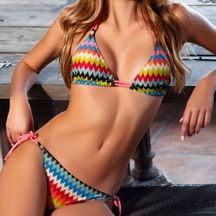Content Menu
● Introduction
● Does Sports Bra Have Size? The Straight Answer
>> Why Size Matters
● Understanding How Sports Bra Sizing Works
>> Band and Cup Sizing System
>> XS to XL Sizing
>> Compression Fit Sports Bras
>> Regional Size Differences
● Why Does Sports Bra Have Size Variations?
● Sports Bra Types and Their Sizing Considerations
>> Compression Sports Bras
>> Encapsulation Sports Bras
>> Combination Sports Bras
>> Adjustable Strap Sports Bras
● How to Measure for a Sports Bra
>> Step-by-Step Measurement Guide
>> Example of Sizing Calculation
● Choosing the Right Sports Bra
>> Types of Sports Bras
>> Tips for Finding the Right Fit
● Does Sports Bra Have Size for Custom OEM Orders?
● Fitting Guide for Buyers: How Does Sports Bra Have Size Impact End Consumers?
● Global Trade and Supply Chain Impact
● OEM Sports Bra Sizing Services We Provide
● How to Answer Buyers Who Ask: Does Sports Bra Have Size?
● Conclusion
● FAQs
>> 1. Does sports bra have size differences in Asia and Europe?
>> 2. Can OEM manufacturers customize sports bra sizes?
>> 3. Does sports bra have size options for plus-size women?
>> 4. Is simplified sports bra sizing accurate?
>> 5. Does sports bra have size charts for online orders?
Does Sports Bra Have Size? Complete Guide for Global Buyers and Brands
Introduction
Does sports bra have size? This is one of the most frequently asked questions among international buyers, fitness enthusiasts, and fashion brands sourcing sportswear. Sports bras, unlike traditional bras, are designed not only with cup and band sizes in mind but also with compression, support levels, and athletic movements considered. For global swimwear and sportswear buyers, understanding sports bra sizes is essential for bulk purchasing, OEM/ODM cooperation, and ensuring final consumers have the perfect fit.
This article explores the full answer to *Does sports bra have size*, including how sizing works, variations across regions, buyer concerns, and OEM production details that swimwear and sports bra manufacturers like us provide.
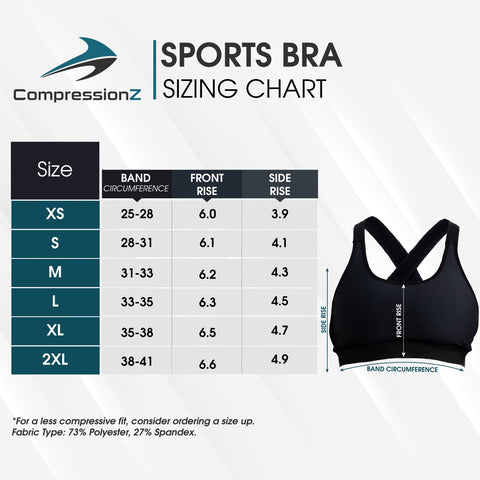
Does Sports Bra Have Size? The Straight Answer
Yes, sports bras absolutely have sizes. However, sizing in sports bras is more complex compared to regular bras since sports bras may come in:
- Traditional band and cup sizes (e.g., 34B, 36C, 38D).
- Simplified alphanumeric sizes (XS, S, M, L, XL).
- Specialized compression-fit options where a single size may fit different bust ranges.
When buyers or OEM clients ask *Does sports bra have size*, the answer depends on which target market they serve, what level of customization they need, and the demands of their customers.
Why Size Matters
Choosing the correct size in a sports bra is crucial for several reasons:
- Support: A well-fitted sports bra provides the necessary support to minimize breast movement during physical activities, which can prevent discomfort and potential injury.
- Comfort: An ill-fitting sports bra can cause chafing, pinching, and overall discomfort, making it difficult to focus on your workout.
- Performance: The right size can enhance performance by allowing for a full range of motion without distractions.
Understanding How Sports Bra Sizing Works
Band and Cup Sizing System
The traditional bra sizing system applies to many sports bra styles. For instance, a 34B sports bra is designed differently from a 38D sports bra, even when both are labeled as "medium support." This method is common in North America and Europe.
XS to XL Sizing
Many global sports bra suppliers, especially for mass production lines, use simplified letter sizing (XS–XL). Brands working with Asian, Middle Eastern, or entry-level sportswear consumers often prefer this system. It reduces complexity and allows faster OEM order turnaround.
Compression Fit Sports Bras
Some sports bras are designed with elastic fabrics and compression fits, meaning a single size stretches to fit multiple customer body types. While practical for fitness beginners, they may lack precision for professional athletes.
Regional Size Differences
- U.S. & Europe: Band and cup sizes dominate.
- Asia-Pacific: Letter sizes (S, M, L, XL) are more common.
- Global OEM Brands: Often request both systems combined on labels.
For manufacturing partners, accurately labeling sizes determines consumer satisfaction and helps reduce product returns.
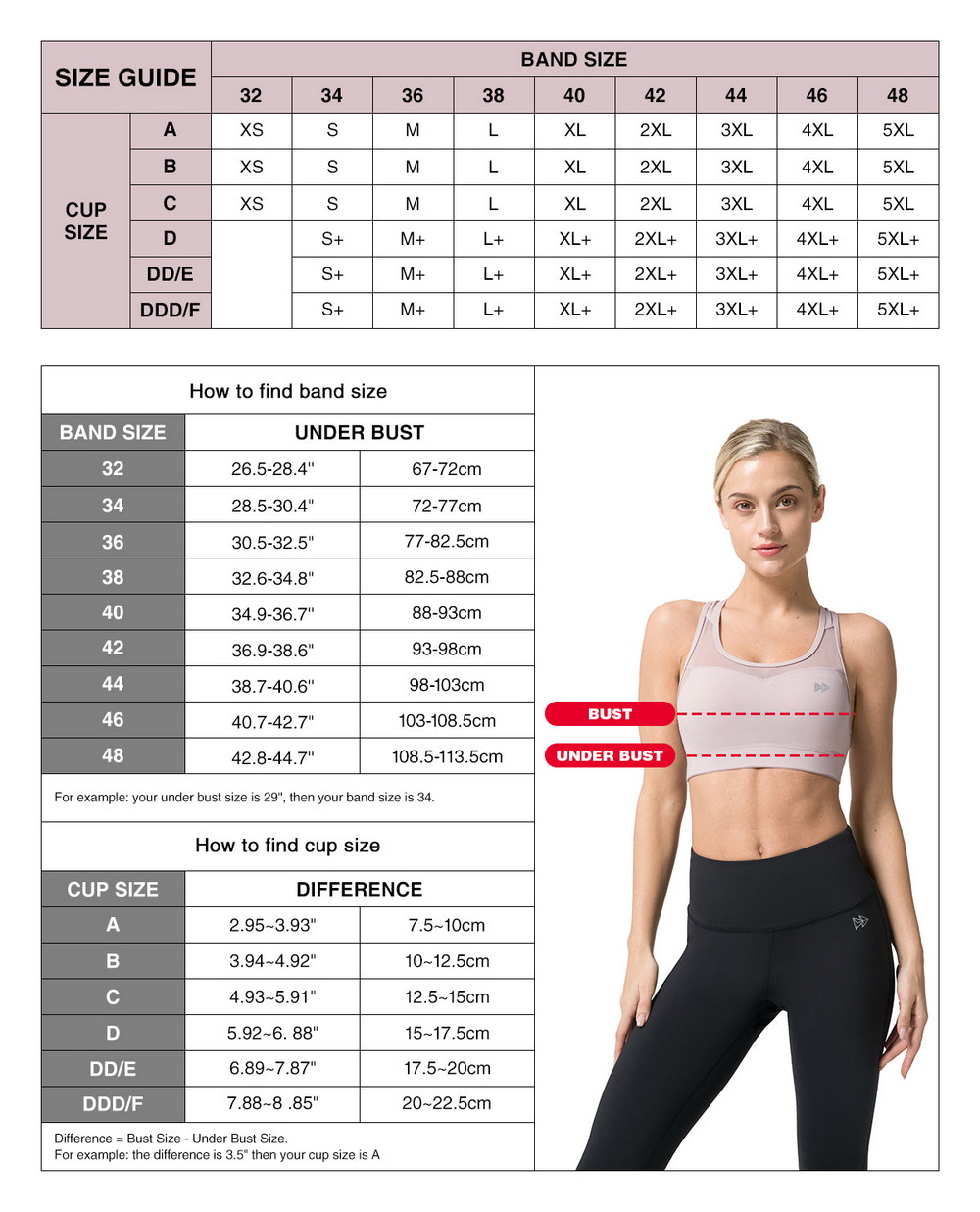
Why Does Sports Bra Have Size Variations?
Sports bras are not a one-size-fits-all product because of the following factors:
- Breast size diversity: Women worldwide vary drastically in bust size.
- Support requirements: High-impact activities demand more accurate sizing.
- Fabric stretch and elasticity: High stretch allows broader fit range.
- Style differences: Racerback, compression, and encapsulated styles fit differently.
When buyers ask *Does sports bra have size*, manufacturers must clarify that sizing depends on design, function, and consumer expectation.
Sports Bra Types and Their Sizing Considerations
Compression Sports Bras
Designed to press the bust against the chest, reducing movement. Usually sized in XS–XL. Ideal for smaller to medium busts.
Encapsulation Sports Bras
Each breast is supported separately with individual cups. These bras usually have traditional cup/band sizes for precision fitting.
Combination Sports Bras
Hybrid designs use both compression and encapsulation features. Manufacturers typically assign dual sizing (e.g., S with cup B–C).
Adjustable Strap Sports Bras
Allow more flexibility in fitting, reducing the strictness of sizing but still labeled in XS–XL or traditional band/cup sizes.
How to Measure for a Sports Bra
Step-by-Step Measurement Guide
1. Measure Your Band Size:
- Use a soft measuring tape to measure around your ribcage, just under your bust. Ensure the tape is snug but not too tight.
- Round to the nearest whole number. If the measurement is an even number, add 4 inches; if it's odd, add 5 inches. This will give you your band size.
2. Measure Your Bust Size:
- Measure around the fullest part of your bust while wearing a non-padded bra. Make sure the tape is level and not too tight.
- Round to the nearest whole number.
3. Calculate Your Cup Size:
- Subtract your band size from your bust size. Each inch difference corresponds to a cup size (1 inch = A, 2 inches = B, 3 inches = C, etc.).
Example of Sizing Calculation
- Band Size Measurement: 30 inches (add 4 = 34 band size)
- Bust Size Measurement: 36 inches
- Cup Size Calculation: 36 - 34 = 2 inches = B cup
- Final Size: 34B
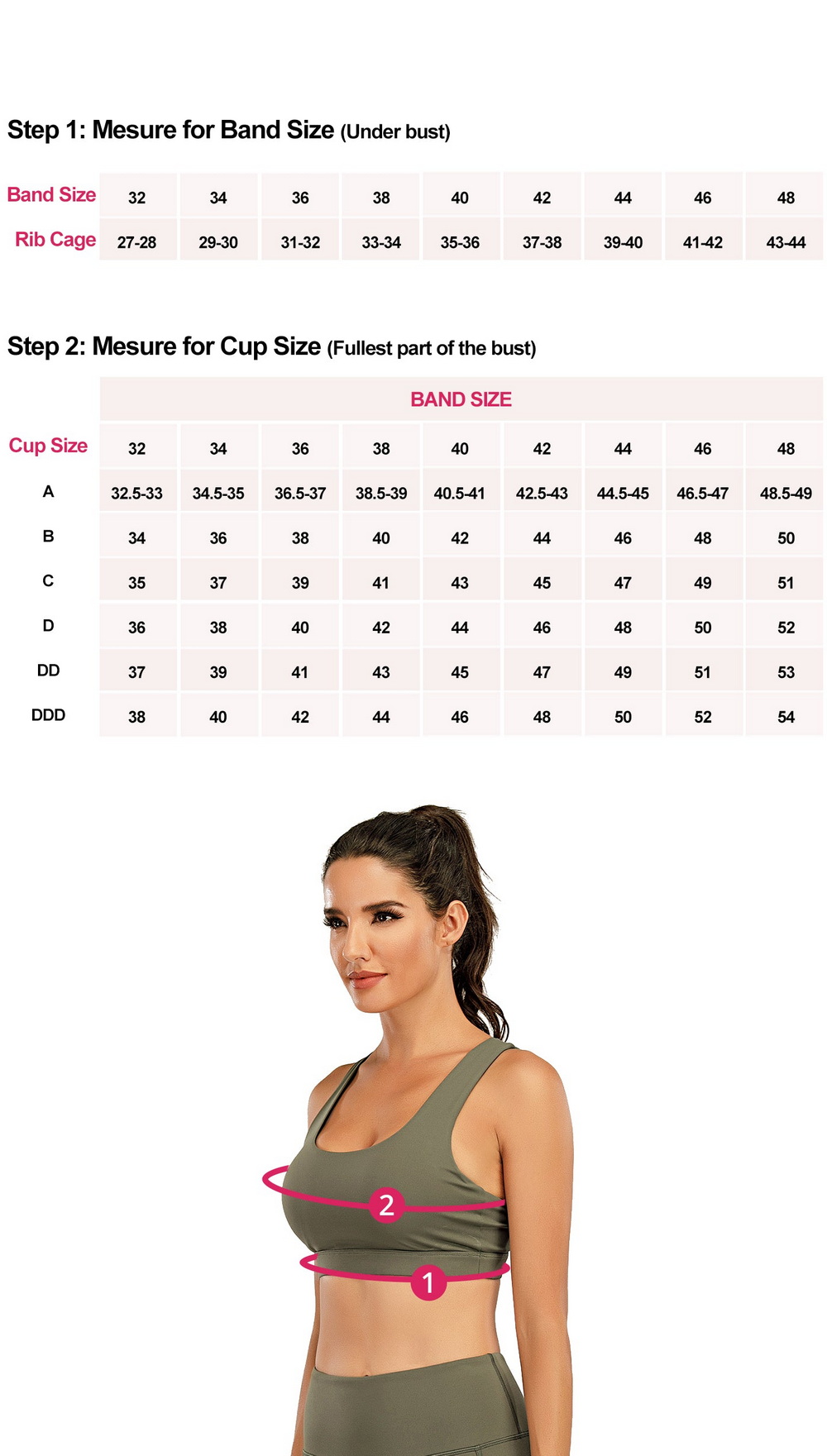
Choosing the Right Sports Bra
Types of Sports Bras
1. Compression Sports Bras: These bras compress the breasts against the chest wall, providing support primarily through tightness. They are ideal for smaller cup sizes and low-impact activities.
2. Encapsulation Sports Bras: These bras have individual cups that support each breast separately, similar to a traditional bra. They are suitable for larger cup sizes and high-impact activities.
3. Hybrid Sports Bras: Combining features of both compression and encapsulation, these bras offer versatile support for various activities.
Tips for Finding the Right Fit
- Try Before You Buy: Always try on sports bras before purchasing. Jump, run, and move around to ensure it stays in place and feels comfortable.
- Check the Straps: The straps should not dig into your shoulders but should be snug enough to provide support.
- Look for Adjustable Features: Many sports bras come with adjustable straps and back closures, allowing for a more customized fit.
Does Sports Bra Have Size for Custom OEM Orders?
Yes. OEM swimwear and sports bra manufacturers, like our factory, can customize sizing systems according to buyer needs. For example:
- European buyers often request traditional EU band/cup sizes.
- Asian buyers usually ask for simplified international letter sizing.
- U.S. buyers often combine both systems with bilingual labels.
Customization ensures global brands satisfy retailers and end-users.
Fitting Guide for Buyers: How Does Sports Bra Have Size Impact End Consumers?
- A sports bra that fits properly reduces breast pain and discomfort.
- Correct sizing aligns with brand reputation, reducing returns.
- Offering extended sizes (XS–XXXL, or 28A–44E) attracts wider customer bases.
- Misleading sizing can damage trust in OEM suppliers.
Retail buyers often test-fit samples before mass production to confirm sizing charts.
Global Trade and Supply Chain Impact
Sports bra sizing is also a logistics concern. Buyers may ask *Does sports bra have size ranges adaptable across markets?*
- Retailer perspective: Simplified sizing reduces inventory stock-keeping units (SKUs).
- OEM factory perspective: Makes mass production faster and more cost-effective.
- Consumer perspective: Needs accuracy in fitting charts for online sales.
Thus, OEM suppliers often create dual-labeling charts to harmonize different regions.
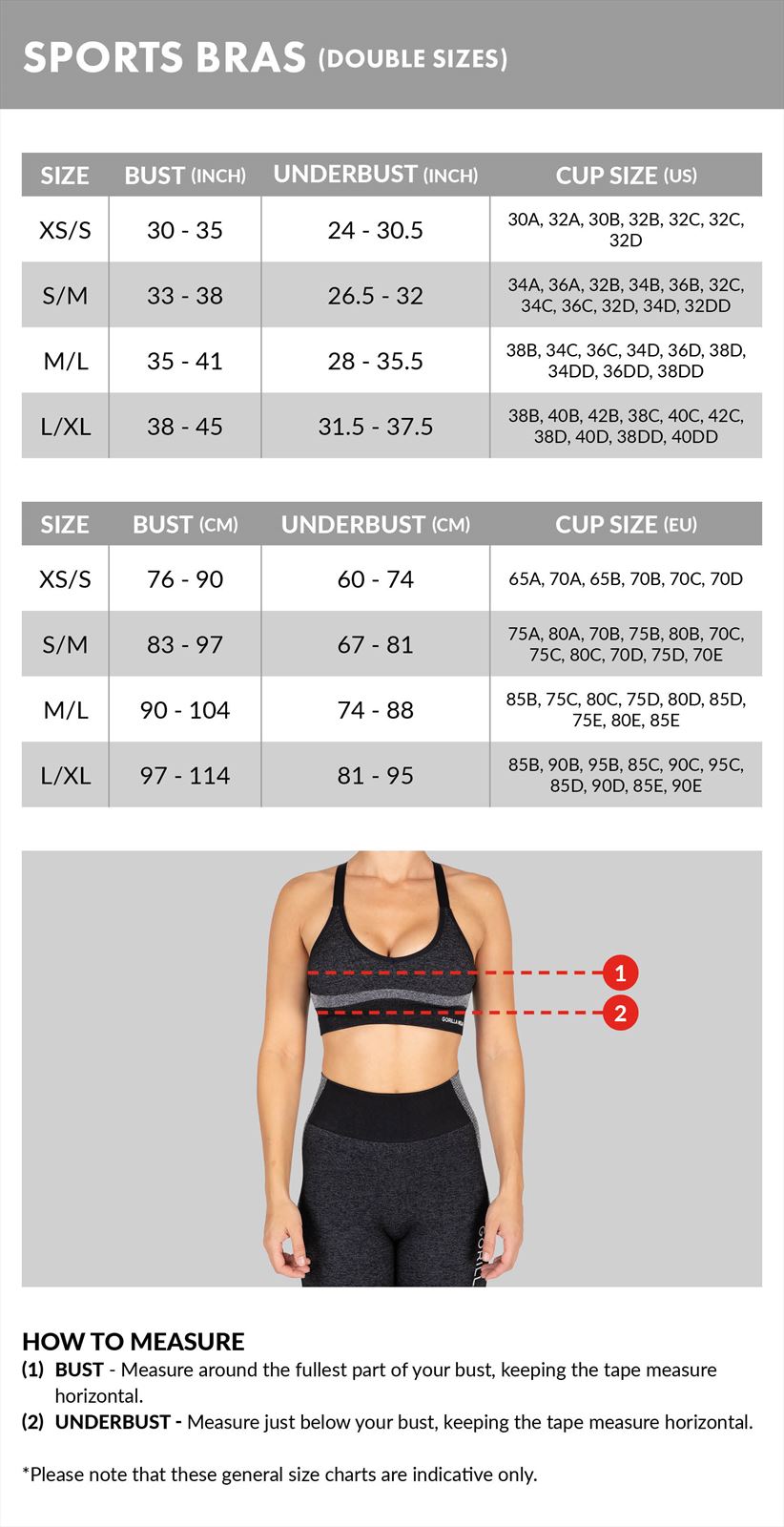
OEM Sports Bra Sizing Services We Provide
As a professional sports bra and swimwear factory in China, we ensure:
- Multiple sizing systems: EU, U.S., Asia-Pacific.
- OEM & ODM private-label production.
- Customizable size charts with brand logos.
- Professional testing for elasticity and support.
- Reduced MOQ (Minimum Order Quantity) for trial orders.
This solves the common question for buyers: *Does sports bra have size flexibility in OEM production?*
How to Answer Buyers Who Ask: Does Sports Bra Have Size?
When international buyers raise this question, brands should explain:
- Sports bras follow *both simplified and detailed sizing systems*.
- A good supplier ensures accurate size grading and fit testing.
- Size availability is part of brand positioning (entry-level vs premium).
- OEM factories can scale sizing based on fabric and market demand.
Conclusion
So, does sports bra have size? The answer is absolutely yes. Sports bras follow multiple sizing systems, including band/cup style, alphanumeric letter sizing, and compression fit ranges. For traders, wholesalers, and OEM buyers, understanding these sizing options ensures consumer comfort, brand reputation, and reduced return rates. Choosing a reliable manufacturing partner who can customize according to target markets is key to ensuring product success.
FAQs
1. Does sports bra have size differences in Asia and Europe?
Yes, Asia usually uses letter sizes (S–XL), while Europe applies strict band/cup sizing charts.
2. Can OEM manufacturers customize sports bra sizes?
Yes, OEM suppliers can follow buyer-specific size requirements, including custom charts, bilingual labels, and extended sizes.
3. Does sports bra have size options for plus-size women?
Yes, many brands and suppliers now offer extended size ranges up to 4XL or cup sizes above DD.
4. Is simplified sports bra sizing accurate?
Simplified sizing (S–XL) works for entry-level users but may not provide precision for high-impact athletes.
5. Does sports bra have size charts for online orders?
Yes, professional suppliers provide digital charts to minimize sizing confusion in e-commerce sales.




















